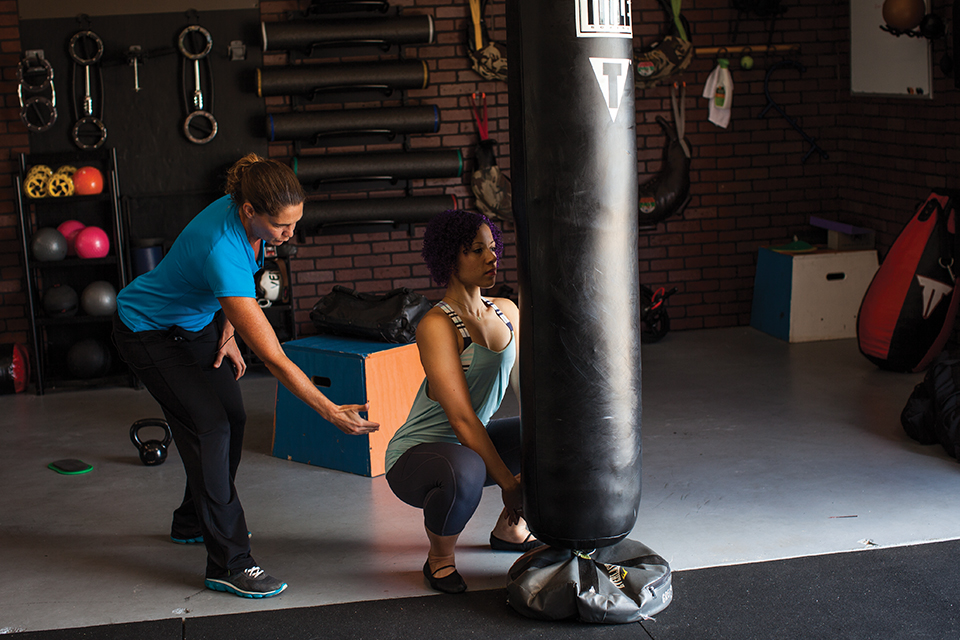Workout: You Do Know Squat

Life demands that we squat. From the time we are infants, our behavior drives us to learn how to move. As we start interacting with our environment, we are driven to roll, reach, crawl, kneel, squat, stand and then take off on that wobbly walk.
In Asia, I personally witnessed many men resting naturally in a deep squat, where their rears touched the back of their heels. It seemed as if this was the most comfortable position they could choose. In contemporary North America, we have built-in conveniences to change the needs to only half the squat distance or even less. So by reacting to our environment of modern conveniences, we become limited in this natural movement.
But then, along comes our workout(s) of the week, and we try to force our bodies into a hopefully deeper squat or even just try to load the limited squat that we have been using from day to day. This is definitely not optimal, so knowing how to pay attention to good form and challenge with deeper, fuller ranges of motion is a great opportunity to bring a healthy squat back into play.
1. Wall Squat
Purpose: Squatting directly in front of a wall or barrier is a great way to cue the squatting motion to descend vertically. A common mistake is to pitch the torso and upper body forward.
• Use a distance that is about half of your foot length away from the wall or barrier, with your feet shoulder width apart and a slightly turned out toe position.
• Then squat while maintaining a safe spine position and make sure that the top of the pelvis does not roll back, rounding the back.
• Squat as deeply as possible without making contact with the wall in front of you.
• Work toward maintaining the quality of movement while improving your depth of the squat.
.jpg)
2. Goblet Squat with Curl
Purpose: This front squat with a wide base comes from the kettlebell world and one of my favorite strength coaches, Dan John. It encourages a deeper descent into the squat because the kettlebell will counterbalance any tendency to sit back into the hips. The curl at the bottom increases time and strength in the low position.
• Set up with a slightly wider than shoulder-width stance, your toes turned out as much as you need to perform the movement smoothly and hold the kettlebell in a bottom-up position in front of the chest.
• While maintaining a safe spine position, descend until the crease of the hips goes below the top of the knees. The knees should be tracking over the feet and not crossing the inside edge of the shoe.
• The outside of the elbows should brush the inside of the upper thigh in this low position.
• At this bottom position, extend at the elbow to lower the kettlebell and then curl it back up to the original position.
• Focus on pushing the floor away from your feet and extend the ankle, knees and hips to return to the start position.
.jpg)
3. Single Leg Box Squat with SandBag
Purpose: Performing the single leg squat on the box while using a front loaded position encourages a full range of motion during the squat and allows the opposite leg to hang freely in a position that encourages the safe spine position of the torso and pelvis.
• Using a box that is tall enough to allow your free leg to hang to the side naturally, begin by standing on a single leg with a light sandbag in the front carry position.
• Descend into a squat with a smooth controlled motion, maintaining ankle, knee and hip alignment. Make sure that you feel the safe spine position and maintain that feeling throughout the movement.
• Push your foot through the box to extend the ankle, knee and hip while maintaining alignment and returning to start position.
• Be sure to control the movement and only descend as deeply as you can with proper technique. When learning the movement, you may shorten your range of motion until you are more confident with technique.

4. Counter Movement Squat Jump
Purpose: This movement challenges squat mechanics while applying the speed of a fast countermovement to load the jump, the jump triple extension and then landing again using foundations of the squat mechanics.
• Stand tall with your feet shoulder-width apart and your natural, slightly toed out position.
• With a safe spine position, descend quickly using triple flexion of the lower body and swinging the arms down toward the ground to increase the loading into the lower body.
• Once you reach a squat position, use the elastic coiling (stretch reflex) of the leg and hip muscles by immediately pushing through the floor and extending the lower body as fast as possible.
• Extend completely to the top of the jump, and return to the ground by landing under control, absorbing the forces, and using the squat mechanics for good technique.
• After landing, return to a standing position. Reset and repeat each quality repetition, one at a time for no more that 5 repetitions per set.
*To find out how much to turn your toes out based on your body’s natural design, stand tall on a smooth surface that your feet can easily slide on. Point toes forward, then squeeze the muscles around your hips and naturally allow your leg and feet to slide on the surface of the ground so your foot position is based on your body.






